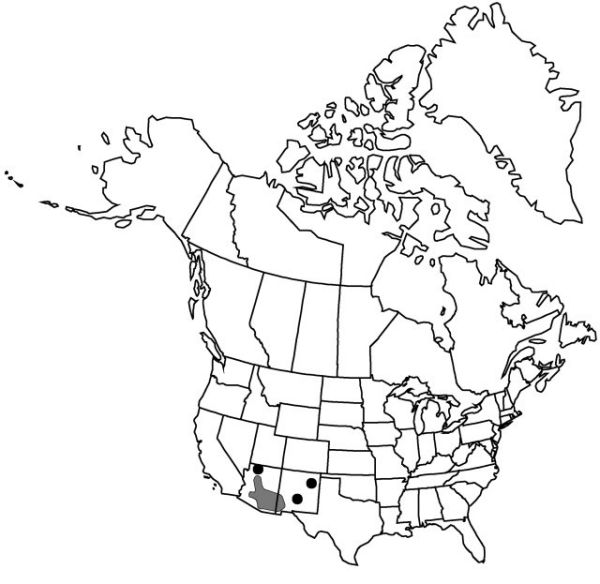Difference between revisions of "Nolina microcarpa"
Proc. Amer. Acad. Arts. 14: 247. 1879.
FNA>Volume Importer |
imported>Volume Importer |
||
| (6 intermediate revisions by 2 users not shown) | |||
| Line 8: | Line 8: | ||
}} | }} | ||
|common_names=Sacahuista | |common_names=Sacahuista | ||
| + | |special_status={{Treatment/ID/Special_status | ||
| + | |code=F | ||
| + | |label=Illustrated | ||
| + | }} | ||
|basionyms= | |basionyms= | ||
|synonyms={{Treatment/ID/Synonym | |synonyms={{Treatment/ID/Synonym | ||
|name=Nolina caudata | |name=Nolina caudata | ||
|authority=Trelease | |authority=Trelease | ||
| + | |rank=species | ||
}} | }} | ||
|hierarchy=Agavaceae;Nolina;Nolina microcarpa | |hierarchy=Agavaceae;Nolina;Nolina microcarpa | ||
| Line 27: | Line 32: | ||
|elevation=900–1900 m | |elevation=900–1900 m | ||
|distribution=Ariz.;N.Mex.;n Mexico. | |distribution=Ariz.;N.Mex.;n Mexico. | ||
| − | |discussion=<p>D. S. Correll and M. C. Johnston (1970) included Nolina microcarpa in their flora of Texas; however, they reported that they had seen no specimen from that state, nor have I. This species is found primarily from western New Mexico through central Arizona. It forms large clumps up to 2 m in diameter and inflorescences that generally are exserted from the basal leaf rosettes. Considerable variation occurs, some of it geographically restricted to southeastern Arizona and southwestern New Mexico. Most such plants from the latter areas have been referred to N. texana or N. caudata, but are here included in N. microcarpa. In the Grand Canyon area, there are variants that have been referred to N. parryi because in width the leaves approach those of N. parryi and they are serrulate. These plants, however, are acaulescent and also are here included in N. microcarpa. B. J. Albee et al. (1988) reported N. microcarpa on rocky slopes in canyons in Washington County, Utah, but the more recent online version of that work excludes it from Utah.</p> | + | |discussion=<p>D. S. Correll and M. C. Johnston (1970) included <i>Nolina microcarpa</i> in their flora of Texas; however, they reported that they had seen no specimen from that state, nor have I. This species is found primarily from western New Mexico through central Arizona. It forms large clumps up to 2 m in diameter and inflorescences that generally are exserted from the basal leaf rosettes. Considerable variation occurs, some of it geographically restricted to southeastern Arizona and southwestern New Mexico. Most such plants from the latter areas have been referred to <i>N. texana</i> or N. caudata, but are here included in <i>N. microcarpa</i>. In the Grand Canyon area, there are variants that have been referred to <i>N. parryi</i> because in width the leaves approach those of <i>N. parryi</i> and they are serrulate. These plants, however, are acaulescent and also are here included in <i>N. microcarpa</i>. B. J. Albee et al. (1988) reported <i>N. microcarpa</i> on rocky slopes in canyons in Washington County, Utah, but the more recent online version of that work excludes it from Utah.</p> |
|tables= | |tables= | ||
|references= | |references= | ||
| Line 36: | Line 41: | ||
-->{{#Taxon: | -->{{#Taxon: | ||
name=Nolina microcarpa | name=Nolina microcarpa | ||
| − | |||
|authority=S. Watson | |authority=S. Watson | ||
|rank=species | |rank=species | ||
| Line 50: | Line 54: | ||
|publication title=Proc. Amer. Acad. Arts. | |publication title=Proc. Amer. Acad. Arts. | ||
|publication year=1879 | |publication year=1879 | ||
| − | |special status= | + | |special status=Illustrated |
| − | |source xml=https:// | + | |source xml=https://bitbucket.org/aafc-mbb/fna-data-curation/src/2e0870ddd59836b60bcf96646a41e87ea5a5943a/coarse_grained_fna_xml/V26/V26_857.xml |
|genus=Nolina | |genus=Nolina | ||
|species=Nolina microcarpa | |species=Nolina microcarpa | ||
Latest revision as of 21:17, 5 November 2020
Plants acaulescent, cespitose; rosettes from vertical, subterranean, branched caudices. Leaf blades wiry, lax, concavo-convex, 80–130 cm 5–12 mm, not glaucous; margins serrulate, with close-set, cartilaginous teeth; apex lacerate; inflorescence leaf blades curling distally, 10–50 cm. Scape 3–15 dm, 1.2–2.5 cm diam. Inflorescences paniculate, 4–12 dm × 10–30 cm, surpassing leaves; bracts caducous, rarely persistent; bractlets 2–5 mm, slightly erose. Flowers: tepals white, 1.5–3.3 mm; fertile stamens: filaments 1.6–1.9 mm, anthers 1.2–1.4 mm; infertile stamens: filaments 0.9–1.2 mm, anthers 0.3–0.5 mm; fruiting pedicel erect, proximal to joint 1–2 mm, distal to joint 3–6 mm. Capsules hyaline, thin-walled, inflated, 4.2–6 × 5.4–6.4 mm, indistinctly notched at apex. Seeds loosely invested in capsules, compressed, 2.2–3.4 × 1.5–3 mm. 2n = 38.
Phenology: Flowering mid–late spring.
Habitat: Rocky hillsides, desert grasslands, oak and pinyon pine-juniper woodlands
Elevation: 900–1900 m
Distribution

Ariz., N.Mex., n Mexico.
Discussion
D. S. Correll and M. C. Johnston (1970) included Nolina microcarpa in their flora of Texas; however, they reported that they had seen no specimen from that state, nor have I. This species is found primarily from western New Mexico through central Arizona. It forms large clumps up to 2 m in diameter and inflorescences that generally are exserted from the basal leaf rosettes. Considerable variation occurs, some of it geographically restricted to southeastern Arizona and southwestern New Mexico. Most such plants from the latter areas have been referred to N. texana or N. caudata, but are here included in N. microcarpa. In the Grand Canyon area, there are variants that have been referred to N. parryi because in width the leaves approach those of N. parryi and they are serrulate. These plants, however, are acaulescent and also are here included in N. microcarpa. B. J. Albee et al. (1988) reported N. microcarpa on rocky slopes in canyons in Washington County, Utah, but the more recent online version of that work excludes it from Utah.
Selected References
None.
